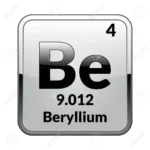
Platinum was discovered by Spanish conquistadors in South America in the 16th century, but it wasn’t until the 18th century that it was recognized as a separate element. The credit for isolating the metal goes to Swedish chemist Carl Wilhelm Scheele, who in 1748 succeeded in isolating a substance from platinum ore that he believed to be pure platinum. However, it was not until 1774 that another Swedish chemist, Johan Gottlieb Gahn, was able to prove that Scheele’s substance was indeed a new element.
The name “platinum” comes from the Spanish word “platina,” meaning “little silver.” This is because platinum was often found in alluvial deposits mixed with small amounts of silver. The metal’s distinctive properties, including its resistance to corrosion and high melting point, led to its increased use in jewelry making and other applications in the 19th century.
Platinum has the symbol Pt and atomic number 78. This means that platinum has 78 protons in its nucleus, giving it an atomic mass of approximately 195.084 u. Platinum is a transition metal that belongs to Group 10 of the periodic table, along with other metals such as nickel, palladium, and copper.
Platinum is a dense, malleable, and ductile metal that is resistant to corrosion and tarnishing. Its density is approximately 21.45 grams per cubic centimeter, making it one of the densest elements. Platinum is also highly malleable and ductile, which means it can be easily shaped and formed into a variety of shapes and sizes.
Platinum is one of the rarest elements in the Earth’s crust, with an abundance of only about 0.005 parts per million. This means that platinum is approximately 30 times rarer than gold. The majority of platinum is found in deposits in South Africa, Russia, and North America.
Platinum is found primarily in South Africa, Russia, and North America. South Africa is the largest producer of platinum, accounting for approximately 70% of global production. Russia is the second-largest producer, followed by North America.
Platinum is often used in catalytic converters to reduce emissions from automobiles. The metal acts as a catalyst in a chemical reaction that converts harmful pollutants such as carbon monoxide and nitrogen oxides into less harmful substances such as carbon dioxide and water vapor.
Platinum is also used in the production of jewelry, laboratory equipment, and electrical contacts. Due to its resistance to corrosion and tarnishing, platinum is a popular choice for high-end jewelry, particularly for wedding bands and engagement rings. In addition, platinum is used in laboratory equipment such as crucibles and electrodes, as well as in electrical contacts for electronic devices.
The world’s largest platinum producers are Anglo American Platinum, Impala Platinum, and Sibanye-Stillwater. These companies are based in South Africa and together account for approximately 60% of global platinum production. Other major producers include Norilsk Nickel in Russia and Anglo American in North America.
The price of platinum can fluctuate greatly due to supply and demand factors, as well as economic and geopolitical events. In recent years, the price of platinum has been influenced by factors such as the COVID-19 pandemic, changes in automotive regulations, and political unrest in major producing countries such as South Africa.
Platinum-190 is the most stable isotope of platinum, with a half-life of approximately 6.5 billion years. This means that it takes 6.5 billion years for half of a sample of platinum-190 to decay into other elements.
Platinum has a high melting point of approximately 1,768 degrees Celsius, making it useful for high-temperature applications. It is also a good conductor of electricity and has a low coefficient of thermal expansion, which means it can withstand changes in temperature without expanding or contracting significantly.
Platinum is also used in the medical industry, particularly in chemotherapy drugs to treat cancer. The metal is used as a component in the drug cisplatin, which works by interfering with the DNA of cancer cells and preventing them from dividing and growing.
The versatility of platinum has led to its use in a variety of other applications, including in the production of dental implants, fuel cells, and even spacecraft. The metal’s resistance to corrosion and high melting point make it a useful material in these applications.
Platinum is a valuable metal, with a price per gram that can fluctuate significantly depending on market conditions. As of September 2021, the price of platinum was approximately $976 per ounce, making it more expensive than gold but less expensive than palladium.
Platinum is often alloyed with other metals to improve its properties or reduce its cost. For example, platinum is commonly alloyed with iridium to improve its hardness and durability, or with copper to reduce its cost while maintaining its desirable properties.
Platinum was once considered a “nuisance metal” by miners in the 19th century because it interfered with gold mining operations. However, with the discovery of its unique properties, platinum quickly became a valuable and sought-after metal in its own right.
Platinum’s unique properties also make it a valuable material in the aerospace industry. The metal is used in components such as rocket nozzles and electrical contacts for satellites and other spacecraft.
Platinum is also used in the production of LCD screens, particularly for televisions and computer monitors. The metal’s electrical conductivity and resistance to corrosion make it a useful material in these applications.
Platinum’s resistance to corrosion and high melting point make it useful in the production of glassmaking equipment such as crucibles and molds. The metal is also used in the production of fiber optic cables and other telecommunications equipment.
Platinum has played a significant role in the history of the world’s economies, particularly in the 20th century. During World War II, the United States government classified platinum as a strategic metal and restricted its use in non-essential applications.
The use of platinum in jewelry dates back to ancient Egypt, where it was used to make decorative objects and jewelry for the pharaohs. Platinum’s rarity and unique properties have made it a popular choice for high-end jewelry ever since.
Platinum has been the subject of numerous scientific studies and experiments, particularly in the field of catalysis. The metal’s unique properties make it a valuable material for a wide range of catalytic reactions, including in the production of fertilizers, plastics, and pharmaceuticals.









